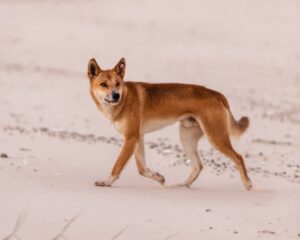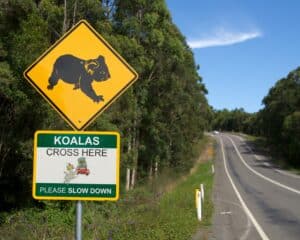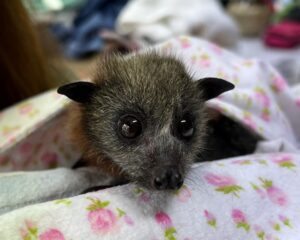New protections for two of Australia’s most vulnerable reptiles following decision at international wildlife conference SAMARKAND, Uzbekistan (3 Dec. 2025) ― Two of Australia’s most vulnerable reptile species have been awarded strengthened protections from international commercial wildlife trade following a decision today at the 20th meeting of the Conference of...
A typical Australian summer means plenty of sun and sand. It’s a season characterised by activity-filled weekends, balmy evenings, and much-needed holidays. With 87 per cent of Australians living within 50km of the coast, it’s no wonder so much of our free time in summer is spent at the beach or exploring new haunts while camping, four-wheel driving, picnicking, or bushwalking.
The summertime provides ample opportunity for Australians and tourists alike to appreciate nature in all its wonder, including our unique native wildlife. However, closer contact with nature also means a greater chance of human–wildlife interactions. It is important to stay safe around wildlife during this busy season, to protect both the animals and you.
Read more below about how to practice being safe around native wildlife this summer:
1. Respect beach-nesting marine turtles and shorebirds
Majestic marine turtles nest along Queensland’s beaches during the summer months. Species such as green, loggerhead, and flatback marine turtles, nest on Australia’s east coast beaches between November and January. Turtle hatchlings then emerge between mid-January and March, before heading off into the ocean. Turtle nests can be at risk of predation and compaction from cars driving on beaches, while deep tyre ruts in the sand can also trap hatchlings. Artificial lights on beaches can also disorient and misdirect hatchlings moving towards the ocean.
Australian summer is also the time of year when various shorebird species—such as the beach-stone curlew, hooded plover, and little tern—nest on beaches. The estuaries, ocean beaches, and lagoons that birds nest in can be shared with holiday-goers. Trampling through areas where there are eggs and chicks, can leave them exposed or disturbed and vulnerable to predation and overheating.
Protecting beach-nesting species involves minimising disturbance of nests and young.
 Hooded plover chick, photo credits Glenn Ehmke via Flickr
Hooded plover chick, photo credits Glenn Ehmke via Flickr
Actions you can take to protect turtles and shorebirds:
- Follow signage erected on beaches regarding safe distances from wildlife e.g. respect fences around nesting areas
- Follow seasonal beach closures for 4WD vehicle access
- Follow regulations for on-leash dog areas to prevent disturbance and predation
- Reduce the use of lights on beaches (including campfires) to minimise marine turtle disturbance
- Report marine turtle nests and predated nests to your local ranger. Learn about marine turtle identification here: Queensland Marine Turtle Field Guide
2. Don’t feed wildlife
It can be tempting to offer a snack from your food stash to wildlife. However, feeding an animal food from outside their natural diet can have adverse health consequences. Moreover, wildlife may learn bad habits from being fed, associating humans with food, and leading to a reliance or increased interest in humans, which at times can cause animals to exhibit aggressive behaviour.
Wild animals are independent and do not need to be fed.
 Dingo on Fraser Island, photo credits Matthew Hickey
Dingo on Fraser Island, photo credits Matthew Hickey
Actions you can take:
- Let animals forage naturally, they do not need to be fed
- After enjoying meals in the outdoors e.g. at camping or picnic areas, store food and rubbish securely e.g. in a vehicle, or dispose of rubbish in lidded bins
3. Keep a safe distance
The best way to admire wildlife is from afar. It’s in their name: they are wildlife. All wildlife deserves to be treated respectfully, which means always maintaining a reasonable and safe distance from them that will not cause any distress. Cornering an animal can cause it to feel threatened.
The best way to view wildlife in their natural habitat is to not disturb them with your presence. This allows animals to express their innate behaviours, which is much more enjoyable for the animal and for you to observe!
Actions you can take:
- Keep on designated bushwalking trails
- Utilise beach viewing platforms to observe shorebirds
- Invest in a pair of binoculars for wildlife-viewing. You can even them to spot marine life offshore such as dolphins and seabirds!
- Photograph wildlife from a safe distance and do not intentionally disturb wildlife to get the “best shot”
- Do not use bright white spotlights or call playback to entice birds. Learn more ethical birdwatching tips here
4. Slow down on the roads
Holidays mean more hours spent in the car travelling to the next exciting destination and increased traffic on the roads. Consequently, native wildlife such as kangaroos, wallabies, and wombats may be at heightened risk of roadstrike during the summer season. Roadstrike can cause injury or even death to wildlife and can endanger human lives too.
Always drive carefully on country roads where animals may be present alongside the roadside or where they may be crossing roads.

Koala crossing, photo credits Aaron Jacobs via flickr
Actions you can take to protect wildlife on the roads:
- Pay attention to road signs that alert you to animal presence in the area including known wildlife crossings
- Avoid driving at dusk and dawn wherever possible, when visibility is reduced, and animals come out to feed along the roadside
- If you find injured or roadstruck wildlife, check the pouch for young and call your local wildlife rescue and rehabilitation group.
5. Be snake aware
Snakes are a natural part of the Australian landscape, and you are more likely to see them in the warmer months. It is possible to share bushland with these interesting creatures by being snake aware.
Snakes can hear low-frequency sounds like footsteps and will either hide or slither away to avoid being detected when approached. Most snake species are not naturally aggressive but can become defensive if provoked. Never attempt to handle or catch a snake as this can increase the chance of becoming bitten.
Actions you can take:
- Keep on designated bushwalking trails
- Avoid walking in tall grass or thickly vegetated areas
- Do not intentionally provoke, disturb or attempt to catch a snake
- Wear appropriate outdoor clothing such as long pants and close-toed, above-the-ankle shoes
- Carry and know how to apply a snake bandage
- Seek immediate medical attention and call 000 if you suspect a snake bite
6. Know who to call for injured wildlife
With warm temperatures and increased traffic during summer, wildlife may be at risk of vehicle collisions, heat stress, and dehydration. Keep an eye out for injured wildlife or wildlife demonstrating unusual behaviour such as panting, lack of coordination, or loss of balance. For more tips for caring for wildlife during high heat, read our blog.
If you find injured wildlife, contact your local wildlife rescue and rehabilitation group. These groups have trained staff who can advise you on how to best support the animal or assist in their rescue.
Flying foxes are particularly vulnerable to extreme heat events that can happen in summer. It is important when it comes to bat species that you do not attempt to handle them, due to the human health risks of biting or scratching and the Australian Bat Lyssavirus. Want to learn more about how you can help protect flying foxes? Read our blog.

Grey-headed flying fox in care, photo credits Paula Paananen
Actions you can take to protect injured wildlife:
- If you find injured, ill, or orphaned wildlife call the local wildlife rescue and rehabilitation group for assistance
- For bat species such as flying foxes-do not attempt to handle them yourself. Contact your local wildlife rescue and rehabilitation group who can assist in locating a trained bat handler.
An Australian summer is a favourite season for many to explore the great outdoors. It’s the perfect time of year to connect with nature, with the season offering opportunities to appreciate and encounter our incredible wildlife. As you do, remember to practise being safe around wildlife for their protection and yours.


